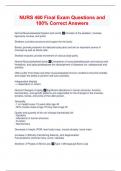NURS 460 Final Exam Questions and
100% Correct Answers
Normal Musculoskeletal System and Joints ✅Consists of the skeleton, muscles,
ligaments, bursae, and joints
Skeleton: provides structure and support for the body.
Bones: provide protection for delicate body parts and are an important source of
minerals as well as blood cells.
Skeletal muscles: provide movement of various body parts.
Normal Musculoskeletal/Joints ✅Complaints of musculoskeletal pain and various joint
limitations, and aging predisposes the development of diseases (ex: osteoporosis and
arthritis)
Often suffer from these and other musculoskeletal chronic conditions that limit mobility
and impair the ability to perform self-care activities.
Independent lifestyle
--> dependent on others
Normal Changes of Aging ✅Significant alterations in human structure, function,
biochemistry, and genetic patterns are responsible for the changes in the muscles,
tendons, bones, and joints of the older person.
Generally:
- 1 cm height every 10 years after age 40
- 50% muscle mass at age 75 they had at age 30
Quality and quantity of life can change dramatically d/t:
- Genetics
- Alterations in human structure
- Function
- Biochemistry
Decrease in height, ROM, lean body mass, muscle atrophy, bone mass
Increase in difficulty maintaining balance, joint degeneration
Foot problems (hammer toes, corns, calluses)
Skeleton: 2 Phases of Bone Loss ✅Type I: Menopausal Bone Loss
,- Rapid phase
- Occurs first 5-10 years after menopause
Type II: Senescent Bone Loss
- Slower phase
- Affects men and women after midlife
In women type I and II overlap:
- Prior to menopause estrogen helps prevent bone loss in women
- Decrease in amount of bone formed
- Occurs in both genders due to aging
Menopause ✅Complete after no period for one year
Average age of last period 51 for Caucasians
Slightly earlier for Hispanic and African-American
Slightly later for Chinese and Japanese
Senescent Bone Loss ✅Amount of bone that is formed is decreased - related to aging
process
due to decrease in thickness of bone wall (hip and vertebrae Fx may occur)
Menopausal vs. Senescent Bone Loss ✅Prior to menopause estrogen helps prevent
bone loss in women
Decrease in amount of bone formed
Occurs in both sexes due to aging
After Menopause- resorption occurs- bone loss,
Deposition- rapid bone growth can't keep up- end result bone loss
Review Box 18-1, p. 459
Sarcopenia ✅By age 75 lose half of all skeletal muscle one had at age 30
Lower extremity muscles not used as much and tend to atrophy sooner
Daily activities keep upper extremities functioning
Muscles ✅Muscle function remains trainable well into advanced age, and the
regenerative function of muscle tissue remains normal in the older person.
Maintaining muscle function is vital to maintaining functional independence.
Joints, Ligaments, Tendons, and Cartilage ✅Hyaline cartilage erodes and tears with
age, allowing bones to come in direct contact with one another.
Ligaments, tendons, and joint capsules lose elasticity and become less flexible.
,The amount of collagen in cartilage does not change greatly but the collagen becomes
stiffer, making the cartilage less able to handle mechanical stress.
Common Musculoskeletal Illnesses ✅3 Metabolic bone diseases:
- Osteoporosis
- Osteomalacia
- Paget's disease
3 common joint diseases
- Non-Inflammatory - joint tenderness, bony prominence & crepitus. Pain & disability
- Osteoarthritis -Degenerative Joint Disease
- Inflammatory -morning stiffness >30 min & night pain, joint effusion
(Rheumatoid arthritis
Gout)
Osteopenia ✅Lower then average bone density but not yet osteoporosis
Serious risk factor for the development of osteoporosis
Important to take action - Vitamin D, diet, possible Rx
Osteoporosis ✅Low bone mass causing weak bones; most common metabolic dx
(50% of women affected)
Risk factors include:
- Increase in age
- Female sex
- White or Asian
- Positive family history
- Thin
- Low calcium intake
- Prolonged immobility
- Smoker
- Excessive alcohol /caffeine intake
- Long term use of thyroid, anticonvulsant, or corticosteroid medication.
Osteoporosis Pathophysiology ✅Definition of osteoporosis:
- Decrease in bone mass
- Deterioration of bone tissue
- Increased risk of fractures
Osteoporosis Prevention ✅Eat calcium and vitamin D
Stay active (weight bearing)
Paget's Disease ✅Chronic bone disorder - normal bone replaced by abnormal bone
Osteitis deformans
, Chronic localized bone disorder
Normal bone replaced with abnormal bone
Unknown etiology
Osteomalacia ✅Metabolic disease
- Inadequate mineralization of new bone
- Deformities of long bone
- Caused by vitamin D deficiency, lack of sun exposure
- Similar to Rickets in children
- Bone pain, fractures
Nursing interventions
- Help patient with life style changes
- Diet
- Exercise
- Pain management
Osteoarthritis (OA) ✅Most common arthritis in United States
Primary reason for joint replacement
Called degenerative joint disease
Non-inflammatory joint disease
Cartilage erodes
Women affected more than men
Leading cause of disability for adults >65
OA - no clear cause but is related to trauma, genetic defect in joint, obesity, more
common with age.
Weight bearing joints most affected
Before 45 y/o more men after more women
Osteoarthritis: Effects & Treatment ✅Life style effects disease of joints but can effect
mentally:
- Depression, job limitations, feelings of helplessness
- Fight OA with exercise-
Stiffness tends to last a few minutes
- Strengthening, aerobic, ROM, Balance and agility
Providers of care for OA- PCP, Rheumatologists, Orthopaedists, Physical and
Occupational Therapists, Dietian, Nurse Educators, Psychiatrists, Acupuncture
Therapists
Treatment- Cortisone injections, OTC meds (NSAIDs), Hyaluronic acid substitutes,
surgery




